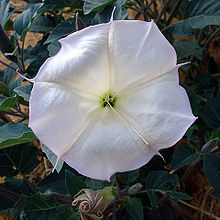Datura wrightii
| Sacred datura | |
|---|---|
 |
|
| Sacred datura in bloom | |
| Scientific classification | |
| Kingdom: | Plantae |
| (unranked): | Angiosperms |
| (unranked): | Eudicots |
| (unranked): | Asterids |
| Order: | Solanales |
| Family: | Solanaceae |
| Genus: | Datura |
| Species: | D. wrightii |
| Binomial name | |
|
Datura wrightii Regel |
|
Datura wrightii or sacred datura is the name of a poisonous perennial plant and ornamental flower of southwestern North America. It is sometimes used as a hallucinogen. D. wrightii is classified as a deliriant and an anticholinergic.
It is a vigorous herbaceous perennial that grows 30 cm to 1.5 m tall and wide. The leaves are broad and rounded at the base, tapering to a point, often with wavy margins. The flowers are the most striking feature, being sweetly fragrant white trumpets up to 20 cm (7.9 in) long, sometimes tinted purple, especially at the margin. Five narrow points are spaced symmetrically around the rim. The plants often can be seen as a ground vine in habit, growing close to the ground and spreading in a very exposed environment with full direct sunlight (cleared roadside). D. Wrightii, blooms from April through October. In clear weather, flowers open in the morning and evening and close during the heat of the day (depending on water availability); in cloudy weather, they may open earlier and last longer.
The seeds are borne in a spiny, globular capsule 3 to 4 cm in diameter, which opens when fully ripe.
D. wrightii is found in northern Mexico and the adjoining southwestern U. S. states, as far north as southern Utah, in open / disturbed land and along roadsides with well-drained (sandy) soils. It is also commonly planted as an ornamental, especially in xeriscapes.
The name commemorates the botanist Charles Wright.
In the US, it is sometimes called "western Jimson weed" because of its resemblance to Datura stramonium. Anglophone settlers in California often called it "Indian whiskey" because of its ritual intoxicating use by many tribes; the name "sacred datura" has the same origin. Other common names include "Indian apple" and "nightshade" (not to be confused with Solanum). The Tongva call it manit and the Chumash momoy. Mexicans call this and similar species tolguacha. or toloache.
...
Wikipedia
